Meta description: what it is and how to make a perfect meta description to attract clicks
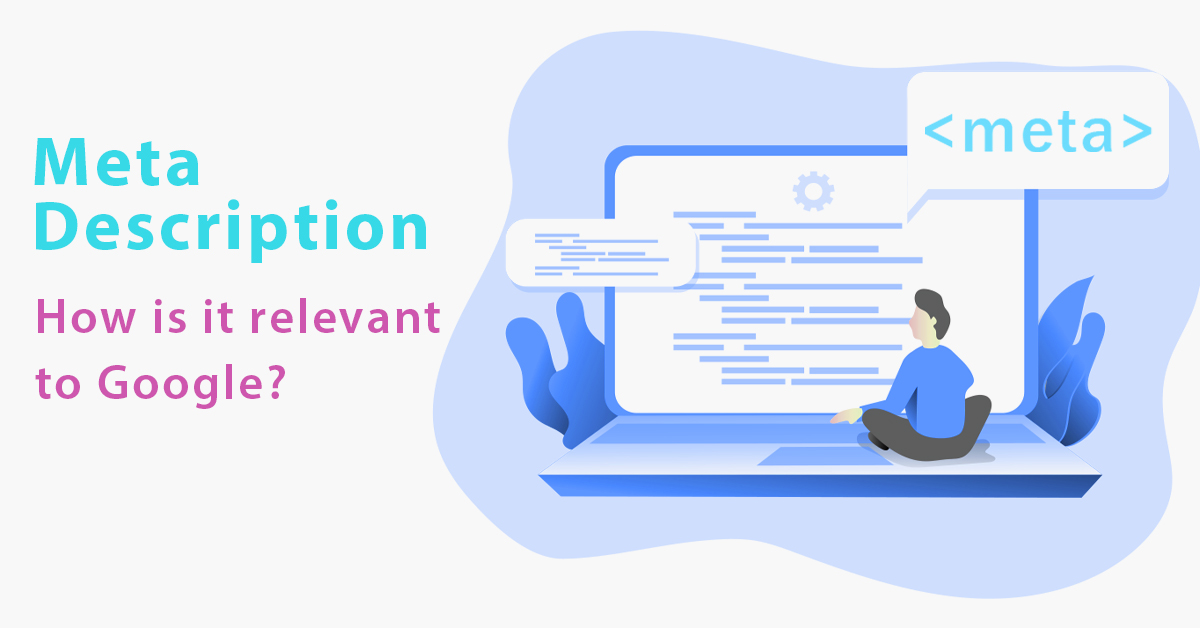
We’re going to cover everything you need to know about the basics of meta descriptions.What are they? Why are they important? How to take advantage of them for the SEO of your website?
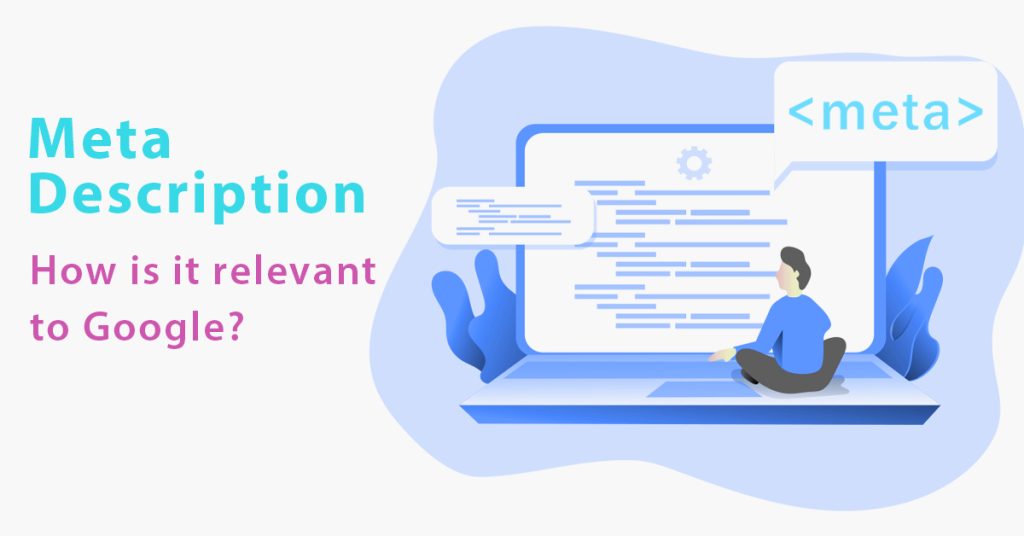
And it is that, whether you are familiar with SEO or not, knowing what meta descriptions are and knowing how to design an attractive meta description for each of your pages, can make a difference and get you more visits.
We teach you practical advice and real examples of how it should be done and you will know how to apply some simple guidelines to start designing perfect meta descriptions.
Are you ready to turn your meta descriptions into a true click magnet?
What is a meta description?
A meta description is an HTML tag used to describe the content of a web page. It is the information that appears in the Google results and that explains what that person will find on your site if they click.
In other words, the meta description is the space that Google offers you to capture the user’s attention and differentiate yourself from the rest of the results, that is, from your competitors.
This description will be displayed below your page title and URL, as it appears in search engine results or SERPs.

To remain visible within Google, your meta description has to contain between 140-160 characters .
Here you can see an example of a meta description in the html code:
<head> <meta name=”description” content=”When writing a meta description, keep it between 140 and 160 characters so that Google can display your full message. Don’t forget to include your keyword!”></head ><br/><br/>
SEO? Meta tags? SERPs? Some of these concepts may not ring a bell, so before we dive deeper into meta descriptions, there are a few ideas associated with them that I want to talk to you about.
I’ll explain which ones.
Concepts prior to meta descriptions
Before starting to write meta descriptions, you need to know some basic concepts that will help you better understand the importance of this meta tag: SEO, copywriting , keywords, SERPs, CTR…
Don’t panic, they are simpler than they look!
And if you already have them under control, you can go directly to the next point.
- Meta Labels or Meta Tags
They are pieces of information that we normally use to describe the content of the page to search engines.
The meta title and the meta description are two fundamental meta tags.
- Search Engine Optimization
Techniques that we use to position a page in the first results of search engines (usually Google) for a specific search.
These techniques are divided into SEO Off page (getting links that point to your website) and SEO On page (all the elements that you can improve on your site).
The meta description tag is inside the On page.
- Keywords or keywords
They are those concepts for which we want to appear when a person searches for them in Google or another search engine.
For example, if you have a dog food store, you want your website to appear in the results when a person searches for the term “dog food” or similar terms such as “dog food”.
In the meta description you must enter that keyword.
If you want to delve into the evolution of keywords, I invite you to read this post about search intention .
- SERPs or Search Engine Results Page
It is the list of results that Google offers you when you perform a search.
In recent years these results have evolved and there are many kinds (videos, images, news…), but the goal is the same: to appear in the top positions.
The conventional results or snippets contain 3 basic differentiated parts: meta title, URL and meta description.

- CTR or Click Through Rate
It is the percentage of clicks that your result receives in relation to the number of times it appears in the SERPs.
Dividing the clicks by the impressions and multiplying it by one hundred we will have the CTR .
You can check it in your Google Search Console account, going to the Search traffic section, search analytics.
The meta description can improve the CTR of your result.
- Copywriting
It is persuasive writing aimed at achieving a specific objective, such as subscribing to a newsletter or making a sale.
We use it to write an attractive meta tag or meta tag that invites clicking on our result and improves CTR and web visits.
As you can see, all these concepts are closely related to each other.
Knowing them will make you better understand the importance of working on the descriptions of your website.
Why are meta descriptions important?
If you bet on SEO on your website or plan to do so, surely you already know how complex it can be to appear in those desired first search engine results.
So, once you’re there, you can’t miss the opportunity to be a click magnet.
That should be your goal: to have an attractive text in your meta description to attract visitors to your website.
Since meta descriptions appear next to your title and URL on results pages, they have the power to help or hurt your click-through rate (CTR).
In other words, when used well, they can help you get more visits to your website, so this tag must be attractive, relevant and comply with a series of guidelines (which I will explain later).
You cannot waste the opportunity to position with some texts that do not reflect the value of what you offer.
They cannot leave the user indifferent, you must arouse their curiosity so that they want to know more, to get the desired click.
In terms of your search result, your meta description has the most real estate (two lines of text compared to one line for the title and one line for the URL), so take the opportunity to sell your website with a meaningful message for search engines and users.
Tell me something, which of these two results are you likely to end up clicking?

Surely you will click on the first one, because it is giving you more information, it tells you about the capacity of the vehicle, it explains the service and approximate price.
It is about becoming the best possible result, inciting the click, being the best option through an optimized and irresistible meta title and meta description.
What is the difference between meta title and meta description?
The two tags appear in search engine results: the meta title or meta title first, followed by the URL and finally the meta description or meta description.
The 3 together (title, description and URL) form the snippet.
The two labels are important, although they have differences:
- The length
The meta title occupies a single line and must have a maximum of 60 characters, while the meta description has a maximum of 150, occupying up to two lines.
Google takes pixels rather than characters into account: for meta descriptions, the ideal length would be between 430 and 990 pixels.
At the end of 2017, this search engine did a test allowing longer meta descriptions, up to 300 characters.
Within a few months he returned to the original 150, although he is always experimenting.
You can use this tool as a character counter to check how your snippet will look and avoid going overboard.
- The objective
We can summarize by saying that the meta title is oriented to Google while the meta description is to the users.
While the former is an SEO ranking factor, the latter is not directly.
The meta description is not in itself an SEO positioning factor, but it can influence the CTR and the CTR is an important factor for Google and other search engines.
Therefore, by improving this label, you will improve the CTR and, in turn, the positioning of your website.
In the end, you should always think of the user when writing both tags, although the description allows you more flexibility than the title, as it is longer and you do not have to stick so much to SEO and keywords.
We see it with an example:

The title of this snippet is designed for SEO, making it very clear which are the keywords to be positioned (“personal trainer in Madrid”).
However, the description gives us the opportunity to tell the user what he is going to find on the web, inviting him to enter.
It is in the meta description where you have to use the weapons of copywriting to persuade the user that you are the best result, that you deserve that click above the rest.
Now that you know why it’s important to have a good meta description, it’s time to get down to business with some tips and examples to inspire you.
How to write meta descriptions
Since click-through rate on the SERPs is considered a potential ranking factor , the best way to make your meta descriptions SEO friendly is to write them with the intention of getting more clicks.
Think of search results like a traditional ad in a newspaper or magazine.
Classic print advertising used headlines and slogans to entice a person to call a phone number or travel to an address to purchase a product at the store.
With search results, your page title is your headline, your meta description is your tagline, and the URL is the address.
Since a meta description is essentially a speaker for a web page, you have to fill it in with active language that makes people want to click on your result.
There are several aspects to take into account when writing a meta description that invites people to click on your link:
1.- Avoid ending with ellipses
Do not exceed 150 characters. In this way you will avoid that the text is cut at the least opportune moment.
Scaling your message to that length and saying everything you want may seem complicated, but it’s just a matter of practice.
An exception: sometimes you can just look to create expectation or arouse curiosity so that the user clicks.
2.- Give the user a reason to click
If you want to be chosen, you will have to give your user a good reason: get their attention, invite them to click, tell them what is of interest to them on your website, why they need to enter, what are you going to offer them. Go to an emotion.
Be concise and persuasive to create a good copy or text.
Whether it is a product, a service or an article, surely there is something good for someone: make it clear what it is.
Think of this description as an ad where you have to sell your content.

3.- Try emoticons and rich snippets
You can add smileys to your meta tags, although Google will reserve the right to show them or not.
You can read here about the use of emojis to increase the CTR.
A couple of examples of using emoticons:


Another way to stand out in the results is to use rich snippets , for which you will need to use the Schema.org repository. Take a look at Google’s recommendations: Best Snippets for your users .
In this way, you give information to search engines that your result is different, so that they show it as such.
Here’s an example:

4.- Be sincere and honest with your promise
Be careful with descriptions that contain promises that are not fulfilled later.
If in the meta you say that you are going to talk about a subject in question or give X advice on something, be honest and make sure that the content of the web responds to what it promises.
If you’re sensationalist or insincere, you’ll get the click, but the user will quickly return to where they came from.
Google will take note and so will that user, who will hardly trust you again.
5.- Include a call to action (CTA)
You have the user there, you have captured their attention, they are reading your meta description, they know what you have for them.
Don’t miss the opportunity to tell him what the next step is, tell him what to do.
Write your call to action (call to action) better in imperative and at the end of the text.
What to write will depend on what you want to achieve: enter now, discover more, read it in the post, choose yours, etc.
Here’s an example where the goal is for the person to come in and fill out a form to request a quote:

6.- Add the keyword in the text
Although you now know that the meta title is the real protagonist for SEO, the meta description can (and should) also include the keyword, better at the beginning of the sentence than at the end.
If the person’s search matches your keyword, you will also get it to appear in bold in your description, as we see here:

Research has shown that including the keyword in the body of the meta description is a signal of relevance to search engines and can help your rankings, since it also better captures the attention of users.
Not a great sign, but it can certainly play a positive role if used naturally without keywords filling up your descriptions, so: Don’t forget to include your keyword.
7.- Use a unique description for each URL
You might be tempted to copy and paste that great description you’ve created, especially if you have a website with many product pages.
Don’t be tempted: your products deserve a unique meta description, just like they deserve a custom product listing.
Large online stores (as you will see below) may not need to do so due to the volume of traffic they already have, but the rest of us mortals should provide differentiated and valuable information to the user so that they want to visit us.
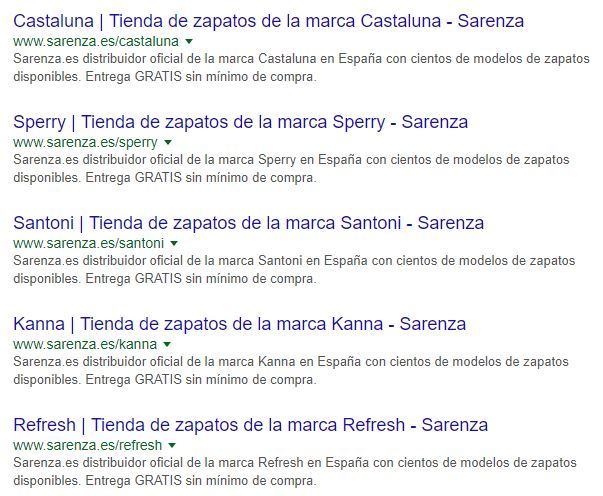
Meta Description Example
If you want to write a description that conveys your website’s unique selling proposition (USP), think: why is my page specifically better than all the other pages in the results?
Don’t be afraid to make an emotional allusion with your message.
Emotional advertising has traditionally been very successful by tapping into people’s feelings.
Let’s see an example:
In this simple description in the SERP we see that this company can offer a model of efficient air conditioning equipment.
More importantly, “they provide comfort as well as efficiency.”
Imagine that your air conditioner is broken while you are sweating in a hot and humid area.
Who do you trust in?
A 2014 study by the Institute of Neuroscience and Psychology at the University of Glasgow suggested that human emotion can be classified into four main categories:
- Glad.
- Sad.
- Angry / upset.
- scared/surprised
This company used emotion in the right way to attract potential customers.
Very clever of you.
Where to change (or create) the meta description text?
Now that you know the keys to writing, you may be wondering, how can I change the description of my page in Google?
It is very simple.
If you use WordPress, install a plugin like SEO by Yoast and write it on each of your pages.
If you have many, start with the most important ones (home, services, key products, who we are, contact…).
Enter the page where you want to change or create the meta description.
Once the SEO by Yoast plugin is installed, this box will appear on the page for you to complete the goals:
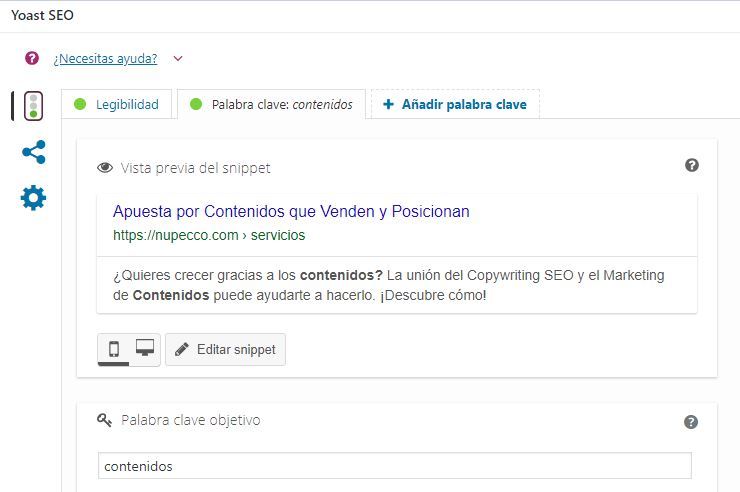
You only have to choose the keyword for that page and get the traffic light to turn green.
This step is not essential, but it can give you clues to know if both tags are optimized.
A very valid alternative to Yoast is offered by Semrush itself with its SEO Writing Assistant tool, try it for free and let it fall in love with you.
Optimize your content
Using Semrush SEO Writing Assistant

The rest of the CMS or platforms usually also have their plugins or extensions for this.
In Prestashop you will have to go to Preferences > SEO + URLs and write the texts of your labels there:

What happens if you don’t write any meta description?
What will happen is that Google (or whatever search engine) will choose for you what text will appear in that crucial place.
Normally, it will take the first sentence that appears in that URL or page of your website, whatever it is.
It is important to note that search engines do not always pay attention to our indications.
And the same thing happens with the meta description: you may write it, follow all these tips and Google decides to put another text.
Because?
We cannot know for sure.
One of the (many) mysteries of Google.
What we do know is that you have nothing to lose by optimizing this tag, but you do have a lot to gain.
Using multiple meta descriptions for a single page
John Mueller, Google’s Webmaster Trends Analyst, responded to a question about using multiple meta descriptions .
He claimed:
So if you include a second meta description tag on a page, we’ll treat that the same way as simply extending the existing meta on the page… there’s absolutely no benefit to using a second meta description on a page compared to just by adjusting the existing one”
—John Muller
SEJ reported that John Mueller stated that Google can handle additional titles and meta descriptions, but that publishers must still write a single meta description and title tag per page.
Generally speaking, you will find that most pages will only have one meta description and that examples of multiple meta description tags are usually due to human error.
However, in some cases, multiple meta description tags are deliberately used.
The reason for this is to give a search engine additional options when it comes to displaying meta information that matches a user’s search query.
Intentional use of multiple meta descriptions
The goal of using it is to match search engine queries with an appropriate meta description tag, which in turn could help improve CTR.
For example, at Semrush we might create a post that explores the various aspects of keyword research.
Within this publication we might want to position ourselves for the following search terms:
- “What is keyword research”.
- “Keyword Research Tools”.
Obviously, these queries have significantly different search intents but are inherently related to each other.
The idea of having multiple meta descriptions is to create two separate descriptions that relate to each phrase.
So, if a user asks “what is keyword research”, search engines will show our result with the meta description tailored to the search query “what is keyword research”.
Similarly, if a user searches for “keyword research tools,” perhaps the second meta description would be displayed.
It is worth noting that there is no guarantee that a search engine will adhere to choosing the desired meta description, so implementing multiple descriptions is at your own risk.
How to implement multiple meta descriptions
The meta description is found in the HTML source of a page, and therefore adding an additional meta description to a page depends on the application you use to create the website.
To add multiple meta descriptions, you need access to your site’s HTML pages and the ability to edit and modify them.
A meta description tag is required to be placed between the main tags in the HTML code and, for best practice, below the page title tag.
For example:
<head> <title>Page Title</title> <meta name=”description” content=”Type the description here.”> </head>
This will add a meta description to your page. To add multiple descriptions you must repeat this process, adding a second meta description between the <head> tags. This would appear as follows:
<head> <title>Page Title</title> <meta name=”description” content=”Enter description one.”> <meta name=”description” content=”Enter description two.”> </ head>
To maximize the effectiveness of multiple meta descriptions, they should reflect the search intent of the highest volume keywords that pages are ranking for or trying to rank for.
This will give search engines the opportunity to select the most relevant meta description for the user’s search.
Should you use multiple meta descriptions?
Unless you are purposely trying to influence search engine results as described above, it is generally considered good practice to include only one meta description for each post created.
Within a page you are optimizing, you should include your target keywords and topics, while making sure that the content is 100% unique and meets user intent for the top queries you are trying to rank for.
Useful online tools to verify your meta descriptions
Below are some helpful tools you can use to test your meta descriptions as you write them.
- Semrush Site Audit – This tool analyzes the health of a website. It will provide you with a list of issues that will allow you to easily see where your website is struggling, including missing and duplicate meta descriptions:

- Semrush On-Page SEO Checker – This Semrush project tool checks if you have a keyword in your title and meta tag and suggests the correct one if you don’t. Also, check out the detailed analysis of keyword usage data in meta descriptions. On-Page SEO Checker also provides you with a detailed list of optimization tips customized for each page of your website.
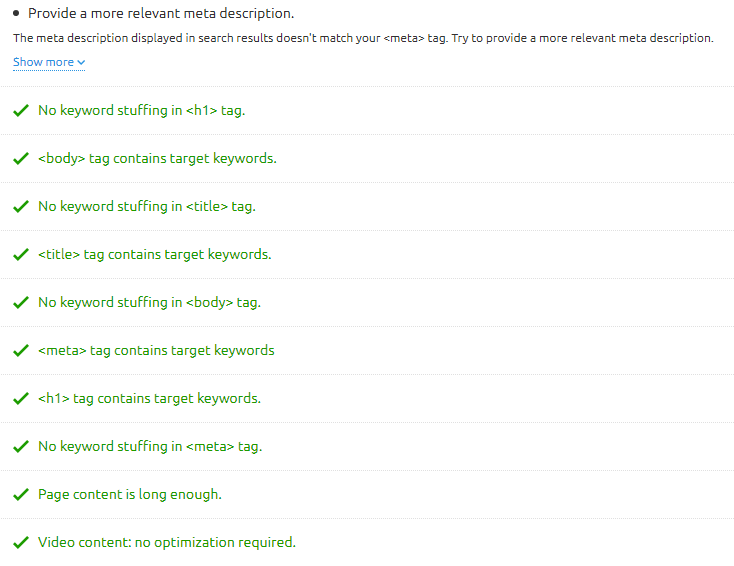
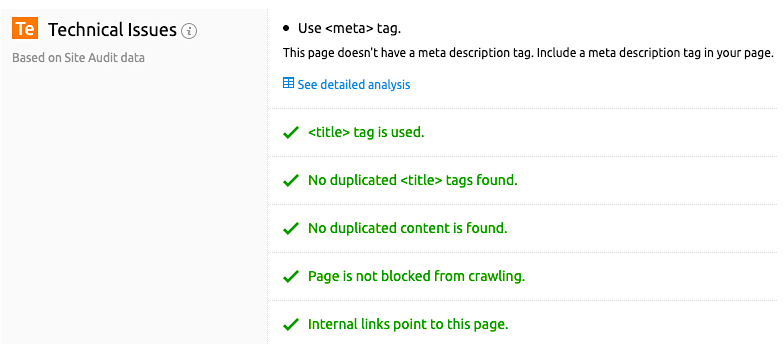
- Portent – This SERP builder allows you to type your meta description along with a title and URL to see how your search result will appear. You can check the pixel width of your title, the character length of your description, and test how different keywords within your description will look when bold.
For more on-page SEO help, be sure to read our on-page SEO checklist .




